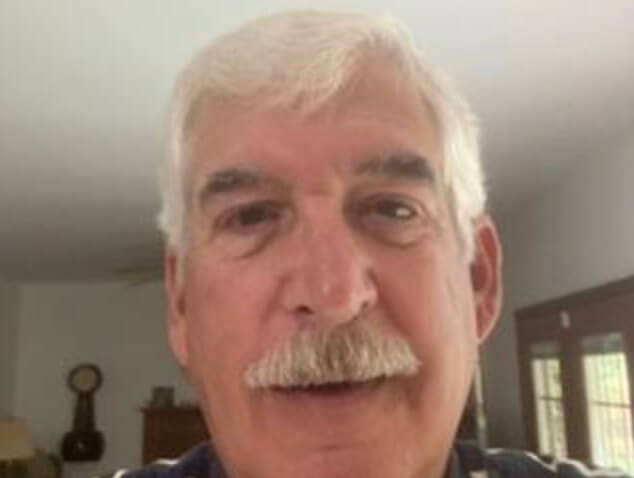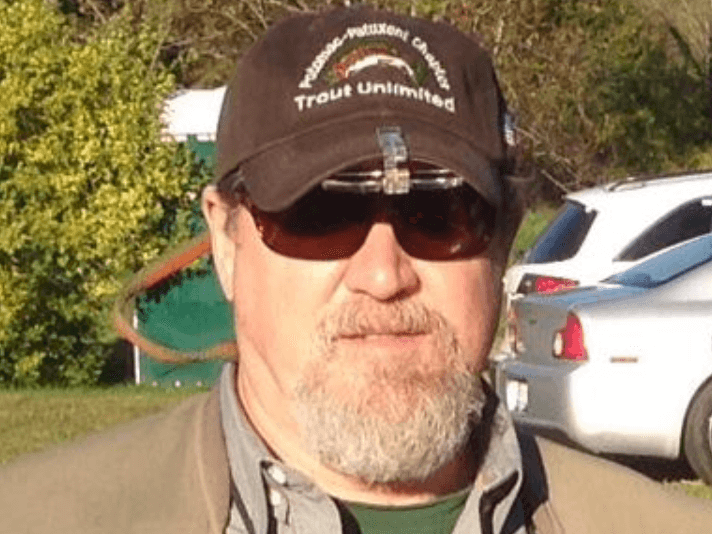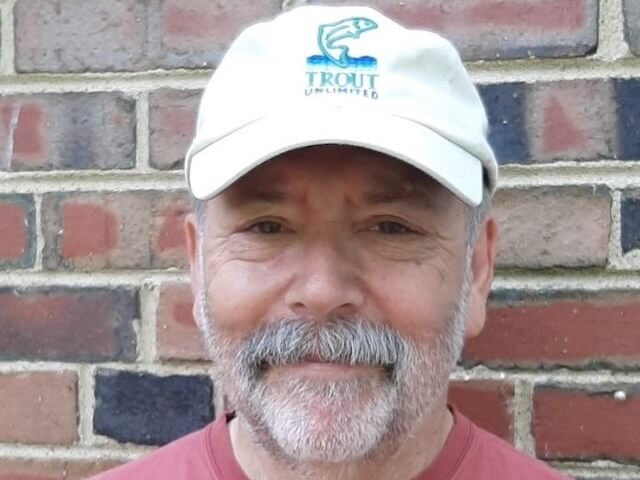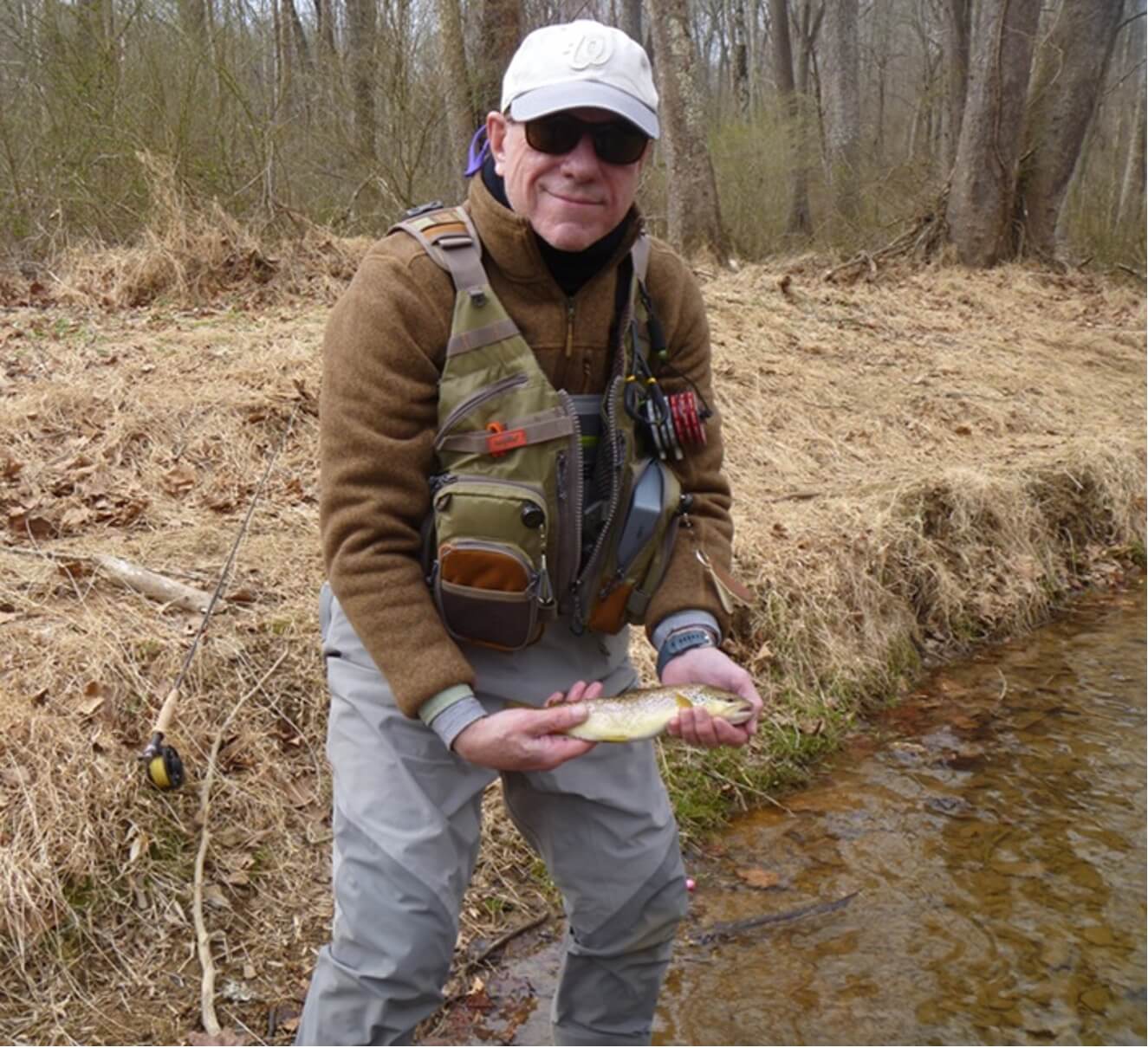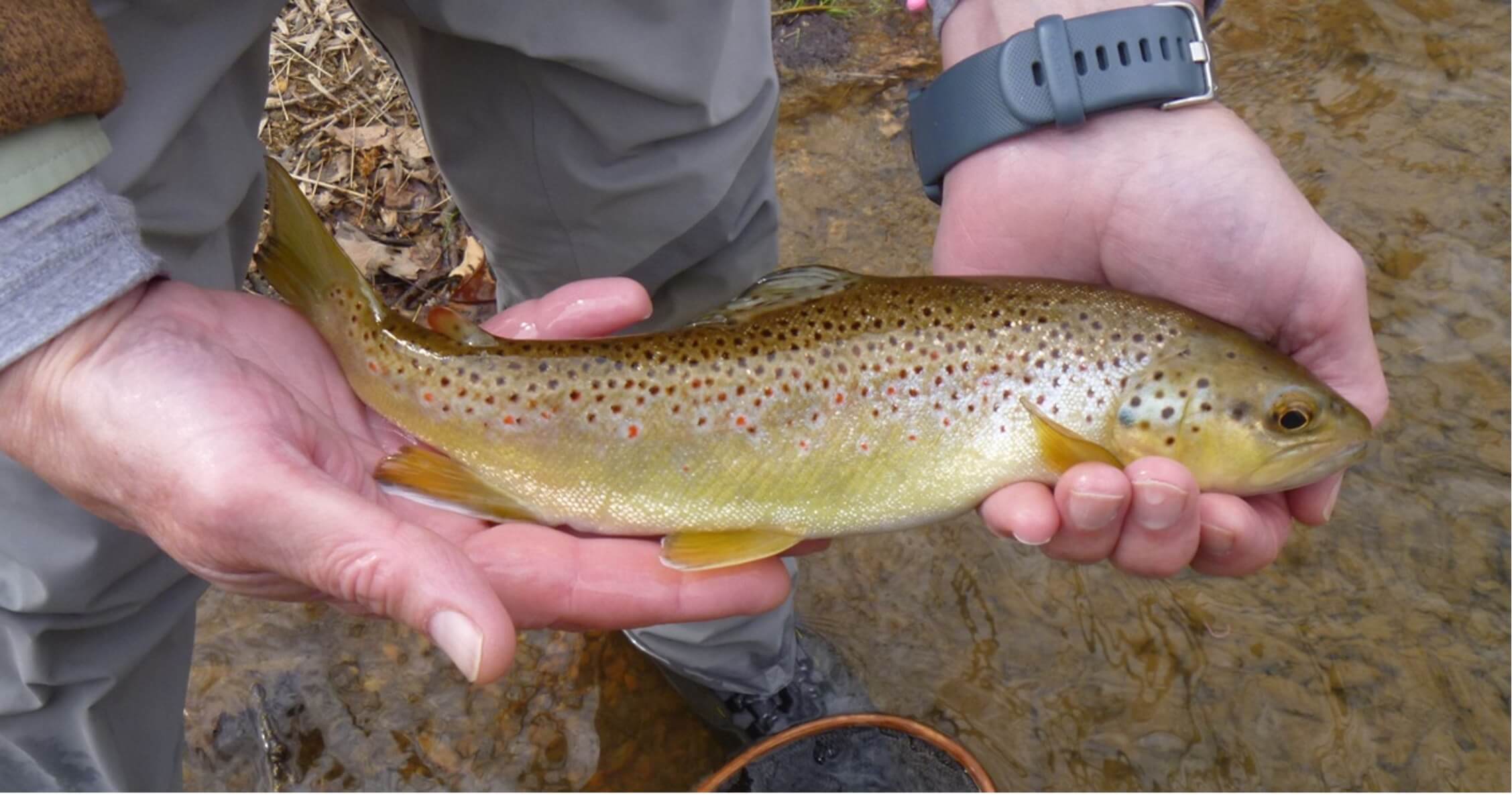2025 Mentor Reports
Allan Rutzen at the Gunpowder October 24, 2025
We finalized trip 3 weeks in advance working around Allan’s schedule and hoping water and weather conditions would be at least acceptable. It was just 38° F when we arrived at Bunker Hill (north) access to the Gunpower River. It was a bit overcast, with some fog still on the river and only 2 other cars in the parking area. Flow was about 145 cfs as we hit the river at 10 am, but the flow dropped to 94 cfs while we were fishing – hardly perceptible drop. Air temperature was about 40° F at start and 58° at end (2 pm) and water temperature was 56 degrees. For a Friday, there was little fishing pressure – only two cars at Masemore and one other fisher at Bunker Hill at 10:00 am. The sun started to cut through the clouds at about noon, finally warming us up a bit. The ‘leaf hatch’ wasn’t bad, perhaps because the winds on prior days had stripped the loose leaves from the trees.
Allan has been fly fishing for a couple years and has participated in several PPTU outings, including the Roscoe and steelhead outings – he had fished streamers, dry flies and nymphs, including some tightlining. He expressed a desire to focus on fishing wet flies / soft hackles so that is where we concentrated our efforts the entire day.
.
On the shared ride to the GP, we discussed safety issues, leaders and tippet, fly types, important knots, rigging, and various ways of fishing two flies. We headed upstream to just below the ‘Desperation Corner’ area and fished downstream back to the BH bridge abutments – ideal water for fishing soft hackles. We spent a lot of time on reading the water and finding where the fish were likely to hold in these Fall and higher water conditions. There were almost no insects present, and we only saw one fish rise the entire day.
We did some casting lessons and practice, along with rod position, line management and mending line for fishing soft hackles. I suggested that he use a Sharpie to mark the 30 foot point of his weight-forward line, and use that to judge both distance and accuracy. We started with a single #16 pheasant tail to start, methodically fishing the 4 key areas: edge of current, bubble lines, around wood debris and around rocks. Allan’s overhand casting was good, and a few pointers like ending rod position and increasing line speed with a single haul, helped his casts straighten out nicely. We soon attached a second fly – a guide’s caddis with bead - to the eye of the first. Then I replaced the caddis with an orangish flymph and Allan connected and landed a 6” brown on the PT soft hackle. We then worked on roll casts – primarily to avoid nearby tree branches – and Allan quickly caught on.
Allan got the hang of things quickly, and we were soon casting across the center current to the far side seams and deeper water, with appropriate high sticking and mends to manage the line. Lots of work on mending resulted in a straighter swing line. A couple casts later he hooked, but LDR’d, what appeared to be an 8-9” brown that jumped and spit the hook (another lesson for keeping a tight line).
Shortly thereafter the flymph scummed to a rock, and it was the last one I had (back to the tying bench). We continued fishing down to the BH bridge abutments, with some hits but no hookups. It was now 1:30 and time to call it a day after 2 ½ hours of intensively and methodically fishing 1/8 – ¼ mile of water.
As usual, I provided Allan with some flies (all soft hackles) and provided some handouts of GP hatch chart, Bob Dietz’s soft hackle guide to the GP, a recent article in Fly Fisherman magazine, and other materials.
Bob Kaiser
Dave Engle at the Gunpowder April 17, 2025
Dave and I started at the bridge. It was still pretty cold that morning, nothing much was going on. A few midges popped off and an occasional small caddis fly. Dave managed to pick up a tiny brown on a pheasant tail nymph. It promptly slipped through the net holes before we could get a picture.
After lunch and a little more fishing downstream, we turned around and headed up to desperation corner. I was surprised no one was there. It had started to warm up and I knew the fish may start being active. I was right. We stepped down off the bank and fish were rising fairly steadily. Dave hooked up and lost a couple of fish. Around 1:30 several Hendricksons started popping off. I also saw my first Sulphur, which surprised me! We tried out a couple of different dry flies before Dave hooked up on another small brown. That one launched itself out of the net. Based on the rises, I knew the fish were picking off emergers, so I found a small deer hair emerger, tied it on and Dave was into some action. It was fun getting him to work on the drift, mending line, etc. Plus we went over timing. Sometimes you can pick out a fish and predict when it will rise next. Dave picked up on what I was saying and on the next good cast he watched his fly drift to where a fish had been rising, we both said "now" out loud at the same time and wouldn't you know it, the fish hit his fly. Dave was a little more surprised than I was, and he missed setting the hook. Good lesson though.
We did get into a few other fish and Dave finally got a decent photo of one to show the grandkids. Fishing wise - I just carried my rod around and watched and instructed all day, but it was fun to see Dave pick up on the details and get into fish.
Bob O'Donnell


Scott Stewart at Morgan Run March 19, 2025
I suggested to Scott that Morgan Run would be a good choice for our outing, and he readily agreed, especially since it was a stream he had not been to before. Scott isn’t new to flyfishing, but recent retirement has kindled the flame, and he expressed to me that he was most interested in learning to be more efficient on the stream, and to focus on other skills like reading the water and tuning up his casting.
Turning onto Jim Bowers Rd, we passed an MNR Police cruiser coming out. I’m always glad to see them on patrol, but as it turned out, we would have been his only customers that day as the parking lot was empty save for one other guy out bird watching (with a lens on his camera that looked like a scaled-down model of the Hubble space telescope!). We suited up and headed to the big pool at the end of the access road. I knew that the stream had been float stocked (thanks!) and didn’t expect to see many fish put there, but we spotted a really nice brown hanging in a sheltered spot that was difficult to cast to. I suggested we revisit him on the way back and headed downstream. Scott just graduated from the PPTU fly tying class, so when he opened his box and pondered which fly to choose, I said one of your ties of course, and selected a black woolly bugger. We then practiced some presentation tactics including dead drifting, swinging, stripping, and line mending. Continuing our way downstream and around the next bend, we found some more fish. The woolly bugger got their attention, but nobody wanted to commit, so Scott opted to switch to a San Juan Worm, and it wasn’t more than a cast or two before the indicator was twitching. Once in the net, admired, and released we worked our way through the pool, but even after a few fly changes, no more takers. However, it proved to be a perfect opportunity to work on Soctt’s roll cast, a technique that had been challenging him. I’m far from a pro caster myself, but it wasn’t too difficult to diagnose the problem, and in short order, he was laying his line out smoothly to the opposite bank. On the way back, Scott tried from several angles to get the attention of that first trout we’d noticed, but no dice.
We ended the day munching sandwiches at the casting deck at Klee Mill. It looked pretty barren, but up in the riffles we did spy two fish and enjoyed watching them chasing each other’s tail before calling it quits.
The next day, Scott sent me a lovely note of thanks for the day out, and summed up his experience from a philosophical perspective, clearly drawn from the “why we fish” well, so enjoy a sip…
“Grace and elegance are the goals of what we do -- whether tying or casting, in line management and fly presentation, the list is long -- but we cannot strive for these goals; rather, they are achieved by being mindful of one's situation -- from what's behind us, beneath us, in the air...to the fish themselves -- and remembering that each movement we make is a choice and each choice carries risks and consequences...and matters.”
Joe Robinson
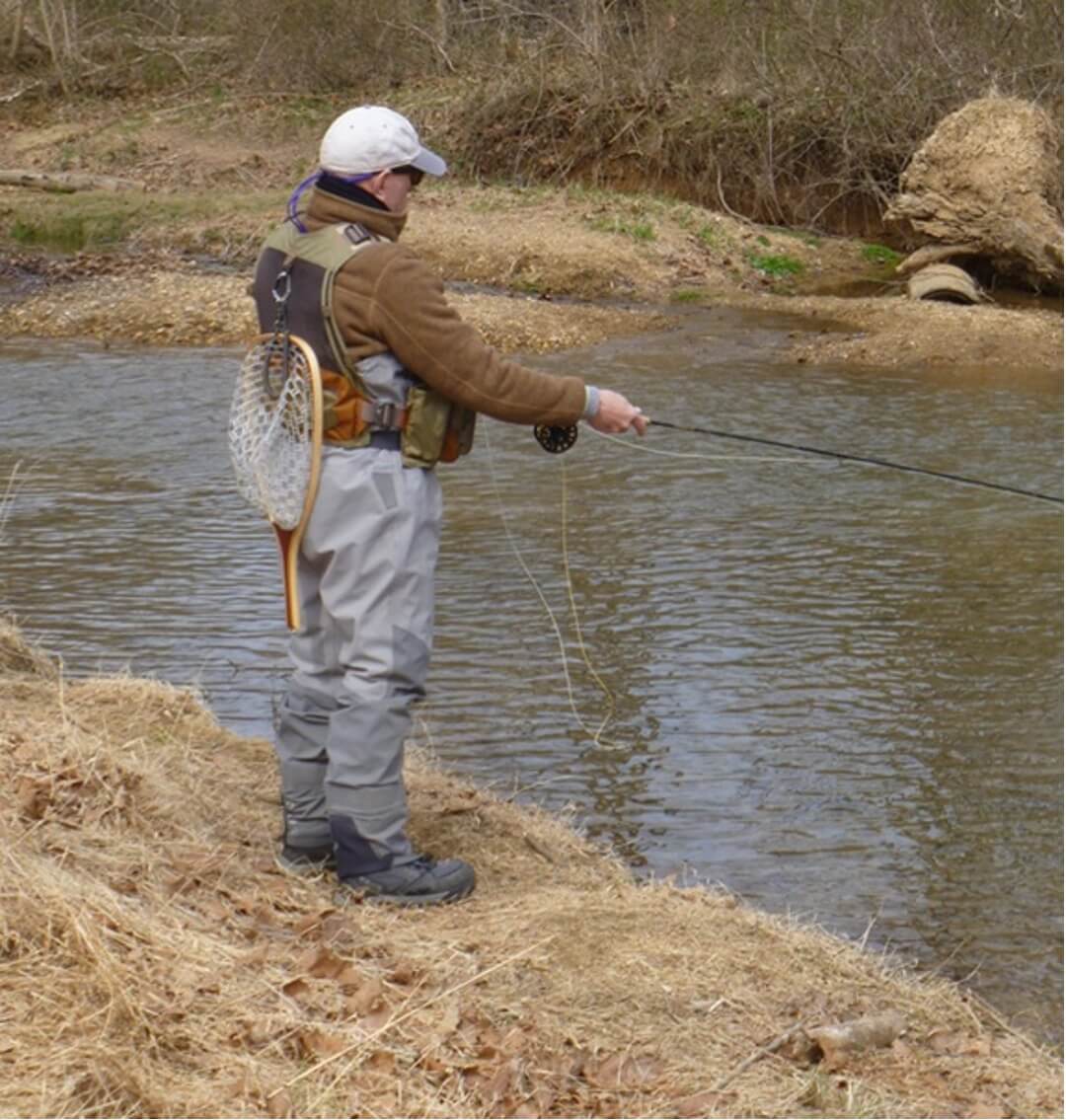
2024 Mentor Reports
Chris Newkamut at the Conewago Creek November 9,2024
Prior to hitting the stream, I suggested that Chris and I meet up for some casting practice on the lawn, and we did just that a few days before at a convenient spot in Rock Creek Park. Chris isn’t new to fishing, but has little experience with a fly rod (though he started out on a high note with a couple of very successful guided trips out west). We went over the basic mechanics of the overhand and roll casts for an hour or so, and when done he stated that he was casting better than ever, so a big win for both of us!
For our time on the water, we decided to join the club outing to the Conewago in hopes of finding some of the recently stocked fish there. It was a beautiful day, perhaps a little too blue out, but with seasonal temps, and little wind. Of course, southern PA has been experiencing the same lack of rain as we have, so it was no surprise that the stream was low, but we made the best of it. With only an occasional midge sighting, I suggested we opt for a garish searching pattern, and we chose a green mop from Chris’ box. Working downstream, we hit any spot that looked potentially fishy but came up empty. We then found ourselves at a wide bend with a long, waist-deep pool. Eagle-eyed Chris spotted a rise out in the middle. My inclination was to switch to a dry, but after waiting for other activity and seeing none, we stuck with the mop. Chris waded out, and five minutes later was into a nice 12” rainbow, one of only a handful of fish caught by the entire group that day, so another win!
On the drive home, we stopped off at Big Hunting Creek for a quick cast at the bridge pool, and then a tour of some other spots that I suggested Chris could explore for another time.
Chris is a journalist by trade, and it was obvious by his many inquisitive and directed questions about gear and technique. The next day he sent me a recap of all the things we had covered, and is already on the prowl for a new rod. I believe he is hooked!
Joe Robinson

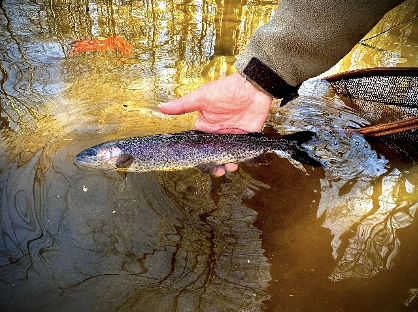
Christina Kanner and Melissa von Heijne at the Gunpowder October 13, 2024
Bob O’Donnell and Bob Kaiser mentored Christina and Melissa up- and down-stream of Bunker Hill access point on the GP river. Joe Robinson, a relatively new Mentor, joined us for the morning session. Both mentorees had attended the CWA/PPTU Fly Fishing 101 class this past spring and had secured the basic gear needed to start stream fishing, but had not fished a stream yet. We spent considerable time suiting up and rigging rods to ensure our mentorees got a thorough lesson what leaders and tippet to use, how to tie a surgeon’s loop and clinch knot, attaching leader to tippet and what size/length leader/tippet combination depending on fly to be fished. After a brief orientation to the river, we adjusted leaders and tippets for swinging soft hackles and using dry flies, checked knots, and headed out.
It was a cool, sunny October day, with a bit of fog on the river at 9:00 am. BWOs might be on the menu! Flow was a comfortable 56 cfs and water temp was about 55° degrees F. Air temp was about 55-60°. The ‘leaf hatch’ was in full swing.
Bob K, Joe Robinson and Melissa headed upstream to just downstream of ‘desperation corner’, where we practiced casting and mending for swinging wet flies, and time reading the water. We then fished this area, catching a smaller brown trout on a #18 pheasant tail soft hackle fly, working downstream toward the old bridge abutment. We had several other hits (not leaves!)
Bob O took Christina into the stream at the old bridge by the BH parking area, and started with casting practice and swinging wet flies and emergers. She connected on a few fish finally landing a small brown on a size 18 Rabbits Foot Emerger, but the fish flopped out the net before a photo opportunity. They then spent some time learning indicator nymphing in the bridge pool, with several touches but no takes.
After lunch Bob K took Christina below Desperation Corner, where we expanded her casting distance with overhead and roll casts, and practicing line mends in different currents. She was casting 20-25 feet with good accuracy and few trees snagged. We fished multiple emerger, dry and soft hackle patterns, but not a single hit. Of course, by now the wind had picked up and leaves largely coated the water surface. We finished the day about 3:00 pm swinging some dry flies both upstream and downstream. Sorry, no afternoon catches for Christina.
Bob O took Melissa to fish the same section Christie fished, going over casting skills trying to make her comfortable with her new rod. Christie did well and started picking up on the mechanics. A few drifts enticed a few takes but no solid hookups. Christie got a lot of casting practice in, utilizing various methods to get her fly where she wanted it to go. After several more drifts at the bridge they moved downstream to try fishing some dry flies and finally a streamer before calling it a day.
Both Christina and Melissa had a great time, learned a lot, and were overly thankful for us making time to take them out.
We departed BH about 3:30 pm, by which time several other fishers had arrived – prior we had the stream largely to ourselves! Masemore parking lot was overflowing by this time, but these seemed to be largely hikers. Good day for learning!
Bob Kaiser and Bob O'Donnell

Andrew Bofto at the Gunpowder May 21, 2024
Andrew Bofto and Bob O'Donnell met on the Gunpowder River on May 21st. The day started out a little odd, as we had appointments early in the day and they both went long which sort of worked out as we met at our agreed meeting point within 10 minutes of each other. Kind of a late start to the day, but we made it work.
The Massemore parking lot at The Gunpowder was full of cars and people so we geared up and headed down to Bunker Hill instead. After reviewing gear and fly setup with Andrew, we proceeded to head upstream to “Desperation Corner”. I knew there would be fish there and hopefully no people. We found the pool to ourselves along with a few active fish. The fish were ignoring several different wet fly patterns that should have worked. I popped on a dry fly and worked with Andrew on casting and presentation techniques. Again after several fly changes, the fish just ignored our offerings. I decided to go off script. Having success at another outing, I tied on a Tan Mopp Fly. I proceeded to show Andrew how to present it and on the first cast I had a hit. On the second cast I hooked into a nice 11" brown trout.
I handed the rod to Andrew and he did his best to mimic what I showed him. Andrew proceeded to hook up on fish after fish but they all got off. We worked on correcting his habit of lowering his rod toward the fish, ultimately giving them enough slack to get off quickly. We fished the water heading downstream, pinpointing likely holding spots, which did hold fish. Andrew appreciated the tips and pointers about the holding water and presentation techniques.
Andrew decided to call it a day and swore he would hook up with me again or come back on his own, which he did. He applied the knowledge learned and caught this brown trout on a fly he tied at this year’s PPTU Fly Tying Class.
Bob O'Donnell
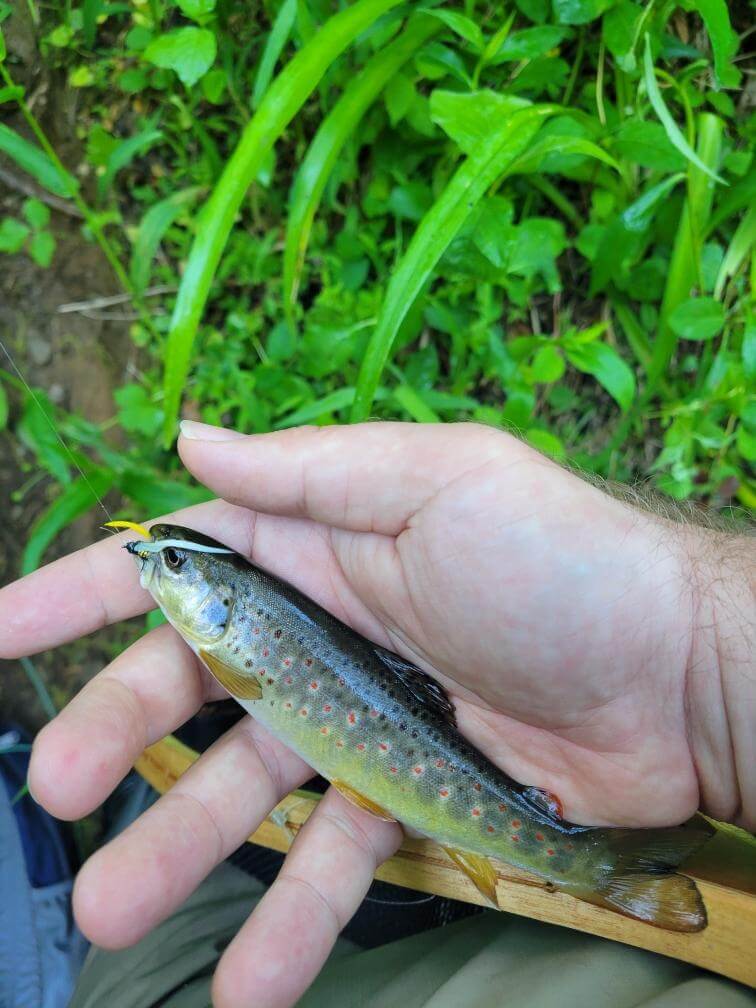
Doug Johncox at the Gunpowder May 17, 2024
I met Doug Johncox at the Bunker Hill (north) access to the Gunpowder River at 9:00 am on May 17, 2024. It was an overcast day, low UV index, Sunday. Flow was about 130 cfs, air temp 60 at start and 72 at end, and water temperature was 52 degrees. For a Friday, there was little fishing pressure – only two cars at Masemore and 2 other fishers at Bunker Hill at 9:00 am. By departure at 3:00 pm, however, Masemore lot was full, but Bunker hill still had several spaces. Certainly the weather conditions impact on sulfurs emerging affected this.
Doug is a new TU and PPTU member who has fly- and spin-fished for bass, salmon, steelhead and panfish. He even tied bass flies on his dad’s Thompson vise. He had all the appropriate gear, but had held off on trout flies pending some additional learning. He wanted to learn trout fishing, so off we went.
After a discussion of safety issues, leaders and tippet, fly types, important knots, and rigging, we headed upstream to just below the Heritage Hemlock area. While the weather was cool and overcast, we observed sporadic sulfur activity and some caddis activity on the 1 mile walk upstream. We discussed stream attributes and trout holding areas as the stream changed character on the walk upstream.
We did some casting lessons and practice for fishing soft hackles, with a #14 pheasant tail to start, then moved upstream to have our backs against the lower riffles from Hemlock Area and began fishing. Doug connected pretty quickly with a 6” brown. His casting – both overhead and roll – was great, so I put on a second fly - a partridge and yellow w/ trailing shuck. Doug got the hang of things quickly, and we were soon casting across the center current to the far side seams and deeper water, with appropriate high sticking and mends to manage the line Just a couple casts later Doug landed another small brown, then a double! Meanwhile, I tried a waterhen bloa and snipe/purple, and immediately took fish on both. This confirmed that it was a sulfur morning.
By 11:00 am the insect activity was waning, but Doug hooked and lost, then hooked and landed another brown trout. We discussed how and why trout were located on the edge of the main current and in the slack water near the far (south) bank, and what was happening as wet flies ceased to attract attention. By 12:30 we walked back to the parking lot for a lunch, where we discussed how weather and climatic conditions effect trout fishing, best times of day to fish, and seasonal variations. I then rigged for indicator nymphing.
After lunch we hiked upstream to “desperation corner” to demonstrate and practice both indicator and tight-line nymphing techniques. We passed a guide and his client we had met that morning, and they reported that sulfur emergers were starting up again. At the “Corner”, we saw just a smattering of rises, and almost no insects, so we stuck with nymphing through the Corner and then about 50 yards downstream. A couple hits, but none to the net before I departed at about 3:00 pm. Doug stayed and kept nymphing. He later reported a “nice” brown hooked and almost to the net before it broke free – call it an LDR. He then switched to the same soft hackles used that morning as insect activity picked up, but no takes. So Doug’s tally was 5 to the net, at least two LDRs, and some missed hits. It was a fun day for both of us.
Bob Kaiser
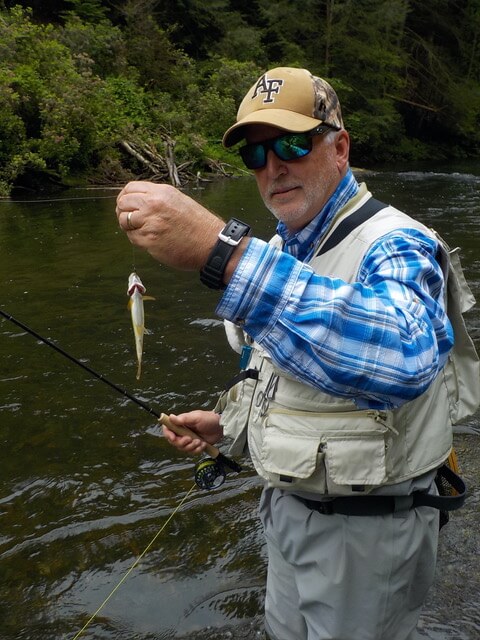
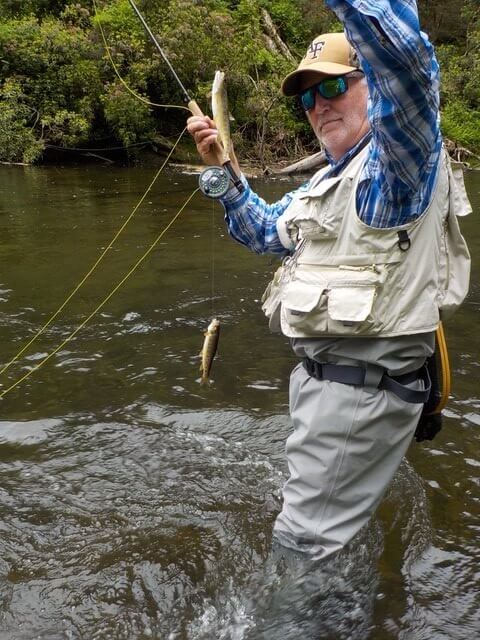
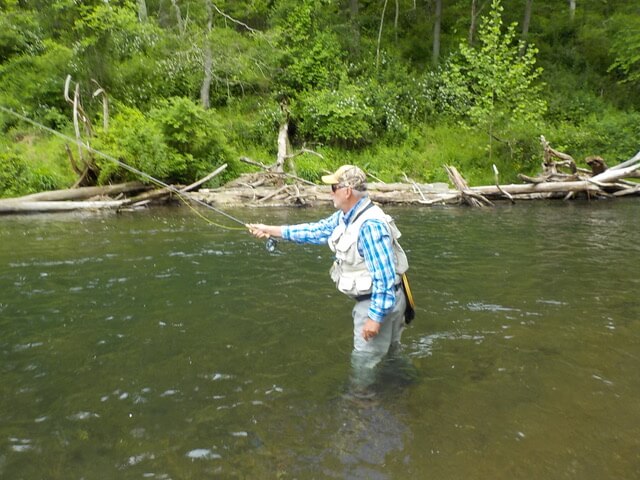
Spencer Black at the Gunpowder April 28, 2024
Our sponsor Bob Kaiser met Spencer Black on April 28th, 2024 at the Bunker Hill (north) access to the Gunpowder River at 9:30 am. Despite previous cancellations due to high water, poor weather, and scheduling conflicts, they persevered on a hot, Sunday morning under clear skies. Flow was about 100 cfs, air temp 60 at start/88 at end, clear blue skies. Sunday is very popular on the Gunpowder as we passed 13 people on the walk out from Heritage Hemlock area to our cars for lunch. By departure parking lots at Bunker Hill and Masemore were overcrowded.
Spencer attended the PPTU-led Fall Fly Fishing 101 class with Howard County Parks and Rec, and wanted to get started fly fishing. He had no prior experience fly fishing and limited experience with spin and bait fishing. He had recently purchased a 5 wt rod, waders and boots, and some accessories and was eager to try everything out!
After a discussion of safety issues, leaders and tippet, fly types, FF approaches, and trout insect diets, we headed upstream to just below the Heritage Hemlock area. Another fisher graciously allowed us to fish the run (he was fishing nymphs, working upstream). We did some casting lessons and practice for fishing soft hackles, with a waterhen bloa on Spencer’s line and purple and snipe / waterhen bloa on the mentor’s demonstration rig. 12 casts by the mentor demonstrated there were ample, hungry fish here, with 4 to the net, and one double. Spencer got the hang of things quickly, and we were soon casting across the center current to the far side seams and deeper water, with appropriate high sticking and mends to manage the line. Spencer hooked and landed four 6” browns on the waterhen bloa. By noon sulfur activity was down but there were some gray caddis about, so we put a guide’s hare’s ear wet on Spencer’s line for a couple casts, but no hits.
We walked back to the parking lot for a late lunch, where we discussed how weather and climatic conditions effect trout fishing, best times of day to fish, and seasonal variations. Bob gave him about 18 flies to get him started, consisting mostly of streamers, nymphs and terrestrials.
After lunch they stepped into the pool at the BH bridge abutments to demonstrate and practice dry fly and nymphing techniques. Spencer caught a small brown on a sulfur parachute dry fly, but indicator nymphing proved unproductive. It was now 3:30 pm and time to head home. Spencer’s tally was 5 hits, 5 browns to the net on soft hackles and dry flies. A great day for both mentor and student.
Bob Kaiser
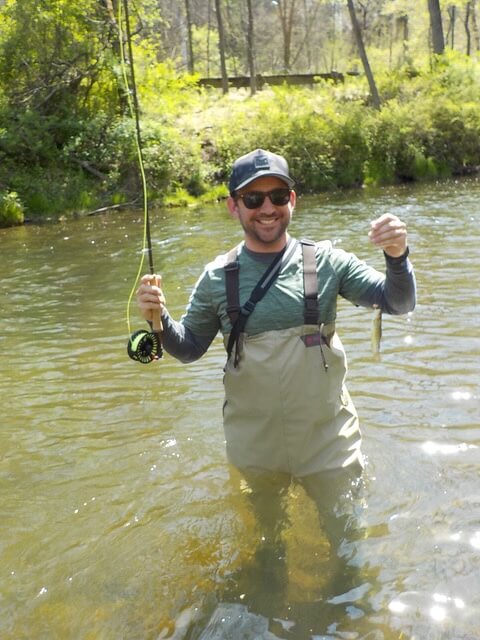
2023 Mentor Reports
Michael Henriques and Charlie Sewell at the Gunpowder July 27, 2023
I finally had the chance to meet up with Michael Henriquez for a mentoring session. In addition to that, Michael asked if he could bring his friend, Charlie Sewell, who was also interested in learning more about fly fishing.
We met up at Bunker Hill on the Gunpowder at 10:00am on the 27th of July.
The weather was actually more cooperative than anticipated. Still hot, but some small cloud cover rolled in giving us a little reprieve from the brutally hot day. Of course it was slightly cooler down by the water and the tree canopy helped a bit. Both guys wet waded and enjoyed the cool temps. I was the only fool in waders!
We discussed gear set up and went over picking out possible flies to use, the why and when of it, and tied a few things on to start off with. Charlie started with a nymph and Michael was using a foam beetle pattern. Lots of casting instruction and reading the water pursued. Got both guys to get use to getting a decent drift. After changing flies and scoring a few "misses" and LDRs, each of the guys hooked up on some wild Gunpowder browns. Both Michael and Charlie missed a couple of decent size fish. Estimating in the 10"-12" range.
Flies that worked or drew attention: Small Foam Beetle, Green Caddis nymph, small Elk Hair caddis; talking 16s and 18s here.
The guys both enjoyed their day on the water and ended up staying longer than anticipated. They gave lots of thanks to PPTU for arranging the mentor session. Additionally, another person in the parking lot stopped me and asked me about guiding, I explained our mentor program to him. He wholeheartedly gave us kudos for what we were doing. Thumbs up to the mentor program!
Here's a few photos attached, a couple of fish leaped off before their photo op. Both guys thought the Gunpowder was a beautiful setting and would make the effort to come back again. We hope to hook up another day. Fun trip, and really nice guys to work with for the day.
Bob ODonnell
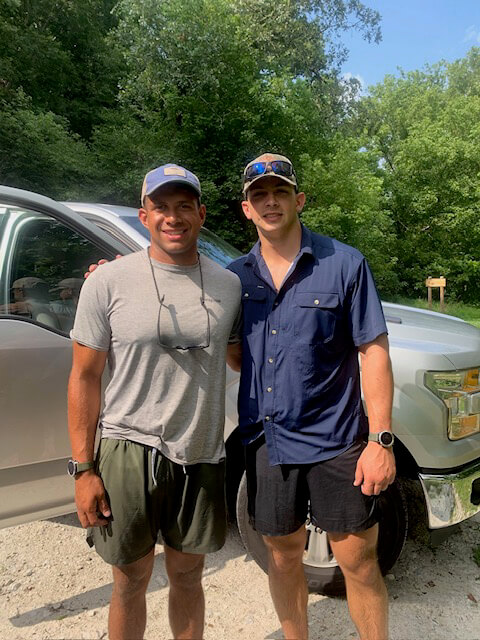
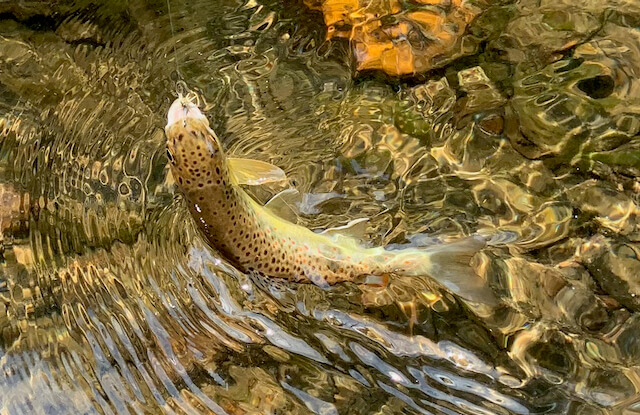
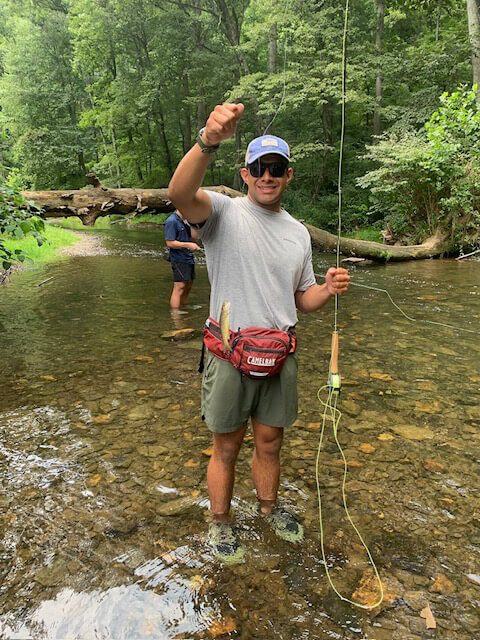
Vanessa and Aldo Avenzini at the Gunpowder River June 24,2023
Bob O’Donnell and Bob Kaiser mentored Vanessa and Aldo up- and down-stream of Bunker Hill access point on the GP river. Both mentorees had attended the CWA/PPTU Fly Fishing 101 class this spring and had fished several times subsequently. After a brief orientation to the river, we adjusted leaders and tippets for swinging soft hackles and using dry flies, checked knots, and adjusted rain gear.
It was a cool, rainy and foggy June day, with light rain most of the day and a heavy rain from about 1:00 – 3:00 pm. Flow was a comfortable 75 cfs and water temp was about 48 degrees F. We were hoping for some BWOs in these weather conditions, but instead were treated to multiple sulfur species emerging throughout the day.
Bob K and Vanessa headed upstream to the Heritage Hemlock area, where we practiced some casting and mending for swinging wet flies, and spent some time reading the water. We then fished this area, catching two smaller brown trout on a Little Dorthea wet fly. We then moved downstream to just above Desperation Corner and continued swinging wet flies, but to no avail.
Bob O took Aldo into the stream at the old bridge by the BH parking area, and he connected on seven browns, two on a foam midge and five swinging a Sulphur wet fly. Aldo also just missed a very nice brown on an Adams dry fly. We then broke for lunch back at the cars. Now the rain started pouring down!
After lunch Bob K took Aldo to just below Desperation Corner, where we now saw multiple rises to emerging sulphurs, but no takes to duns. We fished multiple emerger and wet fly patterns, mostly practicing dry fly casting, mending and line management techniques. We finished the day about 4:00 pm swinging some wet flies and working on roll casting techniques. Sorry, no afternoon catches for Aldo.
Bob O took Vanessa slightly downstream from the BH parking lot, initially swinging wets but switching to drys as several fish were actively rising. A small hatch of Sulphurs and a few caddis developed. After working on a minor adjustment to her cast, Vanessa landed six nice size browns using both a BWO emerger and a Sulphur emerger. Vanessa ended up netting the largest fish of the day, about a 12” brown. Both Vanessa and Aldo had a great time and were overly thankful for us making time to take them out.
We departed BH about 4:30 pm, by which time several other fishers had arrived – prior we had the stream almost to ourselves! Guess the rain forecast scared some folks off, but the weather didn’t get as difficult as forecast. Lesson: fish in the rain!
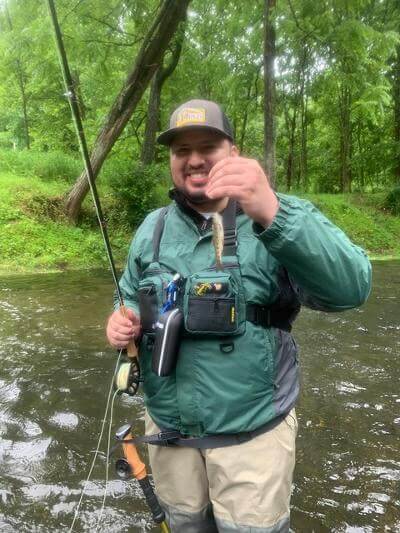
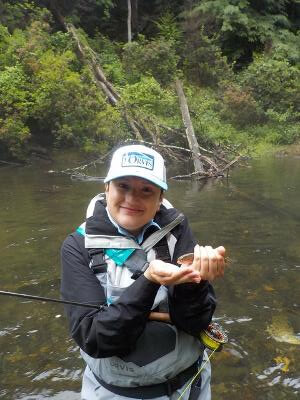
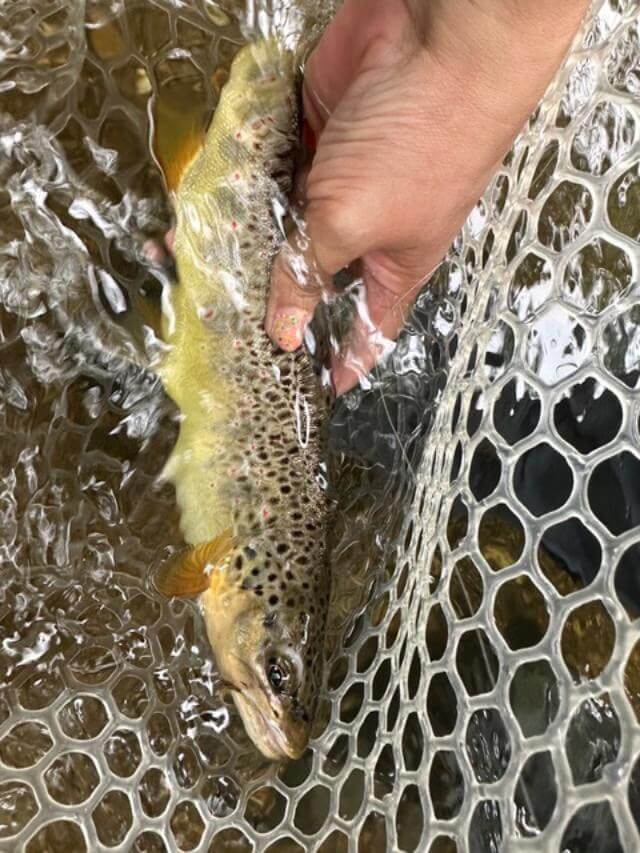
2022 Mentor Reports
Brad Reilly July 9, 2022
I had a great outing with Craig Vanderkolk on Saturday morning, July 9th. We got lucky as it had rained heavily overnight but it had subsided by the time we arrived at the gunpowder. I think the bad weather kept other people from showing up as we were the only ones there. We had a light rain come through for a while, but we were prepared. I caught my first brown trout on a soft hackle! We saw some fish surfacing, so we tried a large dry fly for a while, then switched to a midge pattern. Had an LDR and a couple of other fish approached my fly without biting. Craig was very informative and helpful, letting me use his rod when I experienced a tangle or if a fly change was in order. Overall, had a great time and I am looking forward to getting out more. Thanks again to Craig for his time and knowledge. He made it a great experience! Hope we can do it again sometime.
Brad Reilly
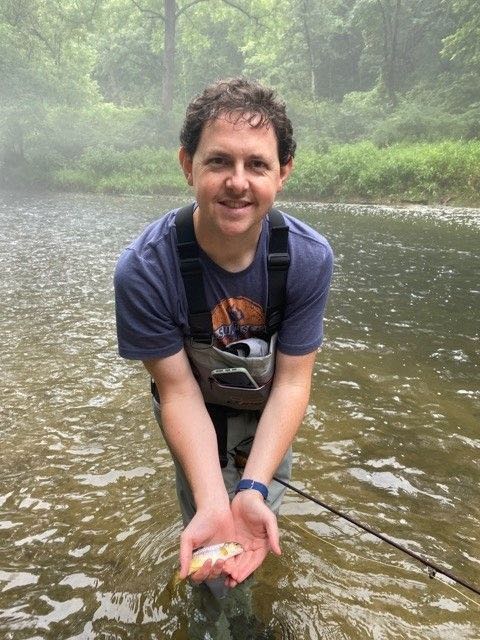
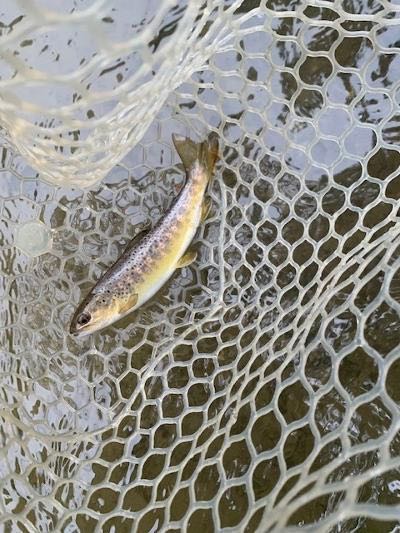
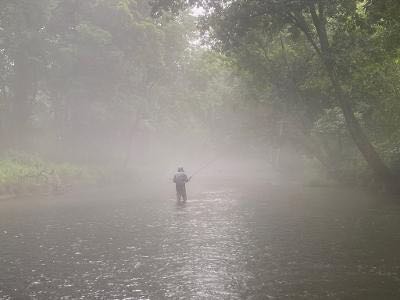
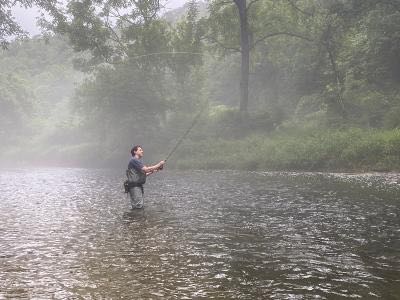
Scott Cernich April 24, 2022
On the morning of Sunday April 24th, I met up with Scott Cernich at Catoctin Creek. The creek is listed in the Gelso/Coburn book, Guide To Maryland Trout Fishing: The Catch-and-Release Streams. Its a beautiful section of water flowing through a park setting south west of Frederick, MD. Great place for a PPTU Outing Lou!!!
Scott and I met up, geared up and headed down to the stream toward the end of the catch & release section. It was a blue bird day with the temps approaching 78 degrees in the afternoon. Scott has been fly fishing for a little while but wanted some tips and pointers, mainly on reading the water. As soon as we walked down to the stream we could see several fish actively feeding by a boulder. We observed the fish a bit and discussed an approach to fishing for them, then Scott had at it. Nothing was happening at first, but after a quick change of flies and adding a little weight Scott was soon into a really nice fat, feisty Rainbow which attempted to leap out of the net several times.
We explored a section of the stream a bit and covered the likely places fish would be holding and how to approach them. Both of us caught and hooked into a few fish including a couple of LDRs and missed strikes. As the sun popped up high in the sky things slowed down a bit and we called it a day. On the way out, I pulled over to look down at the water from the bridge that crosses the creek. I was surprised to see at least 100 fish lined up near the bank. The other side held a few nice fish and a huge golden. A few fish on the upstream side were actively rising, others nymphing. A big bruiser of a rainbow came darting down from upstream. It had to be pushing 24-25" and was as fat as 2 large trout welded together. Hope to see him again.
Photos of Scott's rainbow and a look over the bridge are attached. BTW - Scott is the tall handsome guy. If you zoom in on image 1147, all the long dark marks in a row are fish. Wish I had thought to take the photo through my polarized glasses so it came out clearer. All-in-all it was a fun day. Glad to have Scott as a member of PPTU and hope that others can meet up with him at some of our future outings or meetings if we ever meet in person again. Good fishing with you Scott!
Tight lines,
Bob O'Donnell
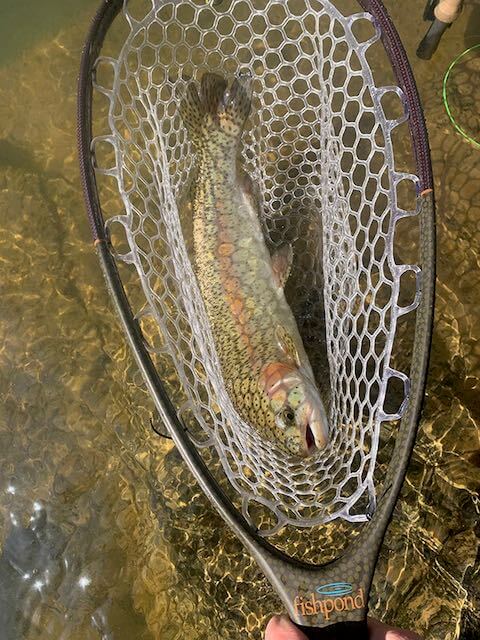
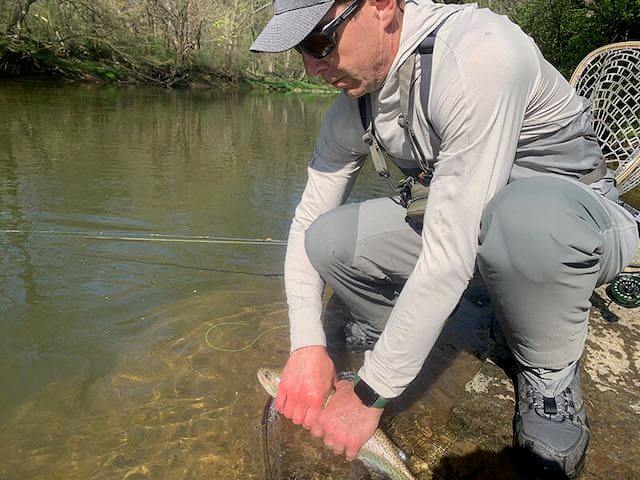
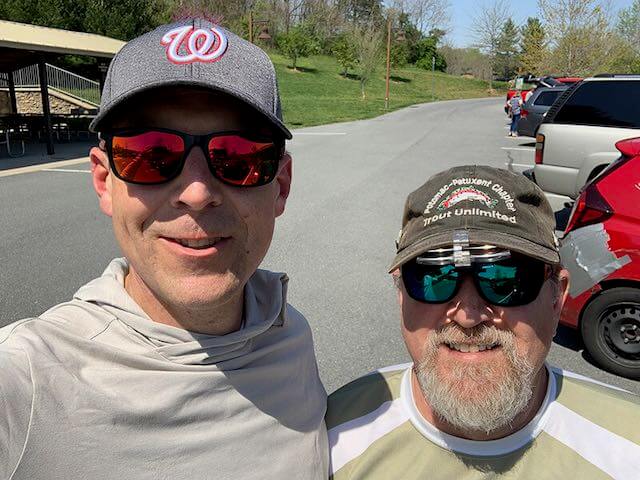
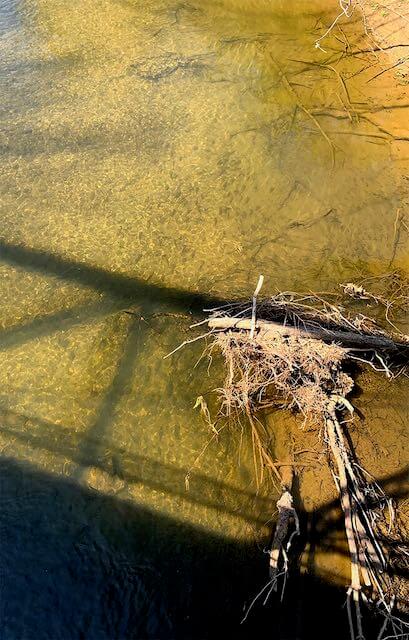
Dana Williams March 17, 2022
I met Dana at the Bunker Hill north access point to the Gunpowder River at about 1:15 pm. It was an overcast day with some light rain; Air temperature 55 degrees, water temperature 46 degrees, flow about 80 cfs. Insects noted: midges, possibly stoneflies (both sparse).
Flies that worked: Pheasant Tail wet, #16, #18
Flies that didn’t work: Stewarts black spyder, dark Spanish needle, partridge and herl, hare’s ear wet, dark Hendrickson wet, march brown wet/flymph (all in #16); weighted black woolly bugger w/ legs.
Equipment: TFO 5 wt, 9’ with floating line.
Fish Caught: 3 LDRs
Dana stated she wanted to learn how to fish wet flies, if conditions permitted, and also use streamers and nymph. She recently transferred on TDY to Baltimore from Austin, TX, where she primarily fished for trout in the Guadalupe River, which is stocked and has some wild and big trout. She had fished the GP several times since arriving, but was unsure of what flies to use and where the fish were hiding out in the various river flows and temperatures. Apparently MD’s air and water temperatures are much colder (at least this winter) than those near Austin. She was a very focused, attentive student who had about four years or so of river fly fishing behind her, but the Austin area has few streams that support trout – limiting her experience on smaller rivers and streams, and the calendar of insect activities experienced in MD.
We started with a parking lot session on leader selection for the GP (and elsewhere), focusing on leader length and size, tippet sizing and maximum size differences between leader and tippet, and tippet sections. I also demonstrated how to make a surgeon’s loop and use it to attach leader to tippet, noting that a surgeon’s knot may be a slightly better option, but allows less flexibility in changing or replacing tippets. She had not fished with long leader/tippet combinations in TX. We hiked upstream to above “desperation corner”, but saw some rises there so continued upstream to just below the Heritage Hemlock area. We started practicing standard and roll casts in the flat, shallow water to accustom her to the long leaders, roll casting with one’s back against the bank/brush, handling two flies, and how to cast and swing wet flies downstream. We then moved upstream to a tree across the stream before fishing in earnest (a prime spot for at least smaller trout, and sometimes some surprises!). We discussed where the fish were likely to be (edge of currents, bubble line, but also in some slack water against the far bank, and to methodically fish close by, then moving out across the river with both casts and stepping toward the river center. There were sporadic rises in the slack water, but none in the currents or edges of the current.
On about the 15th cast, she had a fish hit on the edge of a current, but a strong hook set action overpowered the fish (a 6-8” brown from the brief glance I had). We continued working that section, methodically working across multiple currents and casting into the slack water some 40 feet away. This was a great exercise in line control, mending, and cast placement. She had one more hit here, but was not able to hook it completely – a second long distance release (LDR). We were burning the clock a bit, and in the overcast an early sundown was assured. We then hiked down to just above desperation corner where we had prior seen some rises. Well, no more rises here, so we continued to practice swinging wets, including reach casts down the banks and line and standard casts, through the flat water and down through the riffles to the 90 degree right-hand bend with log-jam, with focus on the edge of the currents. On one line pickup through shallow water, another LDR of a 6-8” brown trout. Dana’s casting and line handling improved rapidly to the point it was near-automatic. We then switched to a black woolly bugger in this deeper water, practicing the swing, retrieve, and guiding the fly alongside logs and rocks. We fished all the way through the corner and beyond but no more hits.
We hiked back to the cars, where I reviewed the leader/tippet “rules”, provided a supply of the flies we had used and some others that we had not (good for GP but also some primarily for elsewhere, such as green weenies), and reviewed the day’s activities. We also discussed the conditions on various portions of the GP special regulations area, and upcoming hatches (grannom, sufur), and stocked streams within an hour or so of Baltimore.
Bob Kaiser
2021 Mentor Reports
Mike Garceau December 4, 2021
Mike Garceau and I finally made it out for our mentoring session.
Mike grew up spin fishing in the Midwest and took up fly fishing about 3 years ago. He had all the basic equipment and has caught one fish on a dry fly in West Virginia.
We met last Saturday on the Gunpowder at York Rd around 10:00. It was a relatively warm day that was partly cloudy. Flow is was 40 cfs and mid 40’s.
We started out going over basics of the stream, weather, insects and moved on the rigging, leaders, tippets and knots.
Around 11:00 we headed upstream past the route 83 section and areas with trees down. On the way we discussed locations of fish and feeding lanes. Found some nice open water along the curves and bends to practice upstream presentations of nymphs. Started with an indicator rig and two flies - beadhead brightly colored perdigon and an unweighted black midge pattern. Tried a few other nymph patterns with various casting techniques and with particular attention to drifts, up and downstream mends and some high sticking.
We tried for about an hour and a half with no luck. I had tied on a small cicada for fun and visibility with a dropper to show some casts and drifts and actually had a medium size fish come up to try and take it.
We then started downstream with a variety of soft hackles of various sizes to demonstrate that technique. Finally ended at the run below the logjam near the route 83 bridges. Here we tried on a dry dropper rig with a large parachute Adams and a small pheasant tail. Mike did a nice job of casting and had good drifts that produced a nice take and set but ended as an LDR.
Overall it was a good outing and I think Mike enjoyed it and learned a lot, despite no fish.
Craig Vanderkolk
Joey Hipolito October 18, 2021
Mentoree: Joey Hipolito
Mentor: Bob Kaiser
When: October 18, 2021 Approximately 10:15-1:00 in the water
Where: Gunpowder upstream of Masemore Rd
Flow: 35 cfs
Insects: almost none - a smattering of midges and maybe 4 tan caddis #14
Conditions: 50 degree gin-clear water, 53 degree air, cloudy with 10-15 mph winds
Fish caught: 1
We had a good conversation about fishing and fly fishing on the 50 minute trip to the GP. Joey had just the prior day attended the Seneca Valley TU FF 101 class, and had picked up a number of good skills and concepts. Today was his first “real” wade fishing trip. He had just recently purchased all his gear and was eager to go and learn.
After gearing up and discussing leaders, tippets, flies types and sizes, protecting the rod, and knots, we hiked upstream to within sight of the Falls Rd bridge before entering the water. We started off with wet flies, swinging a #16 pheasant tail wet in the slow currents. He used only one fly to avoid unnecessary tangles. Joey caught his first fish on a fly rod within 30 minutes, a 4” brightly colored brown. No more luck on the PT wet, so switched to a hare’s ear wet. No luck. We then found ourselves within 100 yds of the hemlock heritage area, and switched to nymphing with an indicator, hanging a #14 bead head hare’s ear beneath the thing-a-ma-bobber. He nymphed down to the hemlock corner with no hits. We then headed back to the car for lunch, a discussion about fly types (wet, dry, nymph, streamer) and how to fish each of them. I gave him an assortment of nymphs, San Juan worms, egg patterns, and green weenies for his next trips.
If its any consolation, none of the 3 other fishers we spoke with had any hits, let alone fish to net.
Ray - sorry, my camera’s pics did not record properly, so I have no pics. I also managed to break the tip on my rod when I tripped over a log and rod tip hit the ground. So much for “protecting the rod”!
Look forward to another mentor trip
Bob
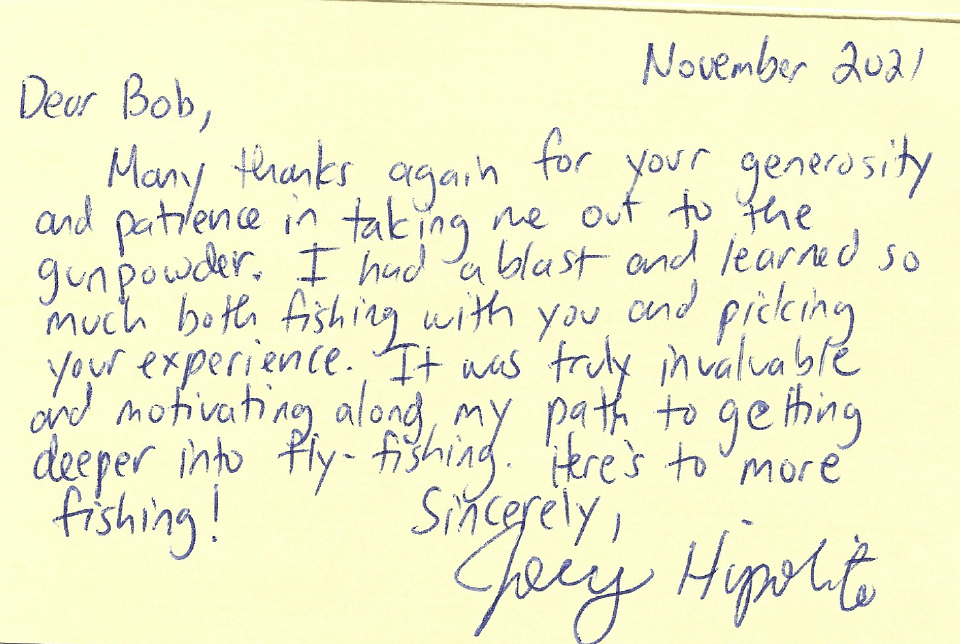
Don Archer October, 2021
At the end of a week in October, Don Archer and I finally met up to fish the Little Patuxent at Savage Mill. The creek had recently been stocked the week or so prior and I figured the chance of getting into a few fish was still pretty good. I couldn't have been more wrong! Anyway, Don must have been enjoying himself because the half day we had scheduled turned into about 9 hours of learning, casting practice and stalking fish.
We covered lots of basic topics from gear setup to knots and presentation. Don got a lot of casting practice in that day and after a few hours there was a major improvement in his casts. After some careful instruction he started to get the feel of his fly rod and how to accurately present his fly. We started off fishing right behind the old mill. Usually one can find a few leftover fish sitting in the deep pool by the first water fall. Nada. We fished the stretch behind the mill for a while and then decided to work up stream. I located a nice run into a deep pool that held a few fish but they were a bit spooked and wanted nothing to do with anything we tossed at them. Don still had fun trying and picked up some presentation options when fishing the type of water we were in. At least one fish seemed to slash at his fly on one cast which provided some excitement. I felt bad that we didn't hook up, but Don said he enjoyed the day and learned a lot.
I followed up with lots of informational links on casting, flies, knot tying, etc. with the idea that he could practice a bit more before his next outing. I also volunteered to take him out again so we could get some fish on the end of his line. It was a nice day overall and neither of us really missed work that Friday.
Bob O'Donnell
Deb Fagan May 6, 2021
I met up with Deb Fagan this a.m. at BHC for a mentoring session. We started off at the bridge pool, which I knew from recent trips, would probably not be holding too many fish, but it was a good place to work on some casting and technique. After a short walk downstream mostly just to drop in and see some of the pools, we headed up to the Smoot, where I knew there would be some active risers. It was a shame they weren't active recipients of our varied offerings of dries, wets, and emergers, but it was a good exercise in fly selection. As we moved up stream, we came to some deeper pools, and not wanting to disappoint, it was time to work on some nymphing skills with the San Juan, and on to the board with two colorful brownies!
Deb was a very eager student and a pleasure to fish with, and I'm sure she will be back to the stream soon for more success.
Joe Robinson
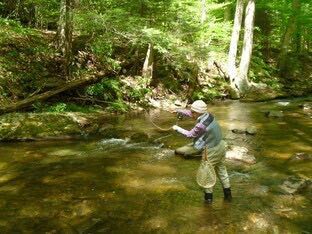
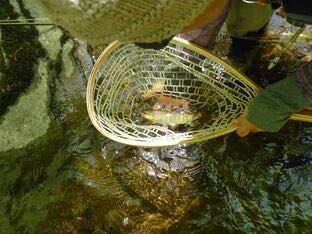
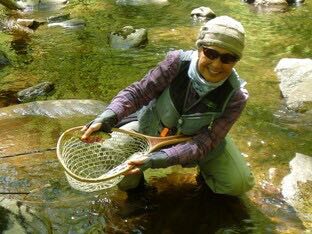
2019 Mentor Program Report
In 2019 6 members listed in the table below were tutored at the Little Patuxent, Morgan Run, or the Gunpowder. First timers received a copy of the Maryland section of the now defunct Mid Atlantic Fly Fishing Guide and a 4 page summary on entomology. This introductory material provided the newcomer with an idea of what flies to use at any given time and general information on identifying insect types. Knot tying was discussed showing two basic knots; the surgeons knot (and surgeons loop) for tying or connecting tippet to leader and leader to line and the improved clinch knot for tying flies to tippet. Different types of leader (the standard 7.5´ 3x nylon tapered leader as described by Jay Sheppard in A Simple Trout Leader System, the Orvis braided leader, the Furled Leader, and the Airflo PolyLeader) were discussed to show them alternative setups. For those with their leader connected to the fly line with a nail knot or to a nylon butt section with a loop, the Cortland braided loop was shown as an alternative for line to leader loop to loop connections. Tippet size was also briefly discussed using the general rule of hook size divided by 3. Thus, 4x tippet is used with size 12 flies while 6x tippet is used with size 18 flies. A brief time was spent on the stream turning over rocks to show some insect life in its early stages. For those with no casting experience, basic casting techniques were shown. On the stream, casting variations including the sidearm cast and the roll cast were demonstrated to avoid overhanging trees and brush behind you. Basic short line nymphing techniques with a strike indicator and/or dry fly fishing techniques were demonstrated. Line mending was demonstrated to insure drag free fly presentation. A combination rig was also demonstrated and/or discussed using a dry fly such as an elk hair caddis or royal wulff along with a bead head nymph. The bead head nymph is attached as a dropper fly on about an 18" to 24" piece of tippet tied to the bend of the dry fly hook using the improved clinch knot. With this setup, the dry fly acts as a strike indicator to detect when a fish takes the bead head nymph. Two dry flies, two nymphs, and a streamer with a dropper nymph combination were also mentioned along with the advantages and disadvantages of these combination rigs.
|
Member
|
Dates
|
Streams
|
Fish Landed
|
Fish On
|
Insects Observed
|
|
Bryan Sirotkin
|
3/8/19
|
Little Patuxent
|
3
|
5
|
A black sedge
|
|
Chuck Ridgely
|
3/18/19
|
Morgan Run
|
1 | Several Strikes |
Few midges
|
|
Peter Schuler
|
5/28/19
|
Gunpowder
|
|
|
A few sulphurs and midges
|
|
Josh Crotty
|
6/5/19
|
Morgan Run
|
2 | 2 |
Some crane flies
|
|
Peter Schuler
|
6/26/19
|
Morgan Run
|
6
|
Several Strikes
|
A few beetles and midges
|
|
Rex Wingerter
|
7/1/19
|
Gunpowder
|
|
A few caddis & a couple sulphurs
|
|
|
Yusra Ahmad
|
7/5/19
|
Gunpowder
|
|
Few bugs
|
|
|
Josh Crotty
|
7/15/19
|
Gunpowder
|
|
|
Few caddis
|
|
Josh Crotty
|
8/14/19
|
Gunpowder
|
1
|
1
|
Few bugs
|
|
Yusra Ahmad
|
11/2/19
|
Morgan Run
|
|
|
Few bugs
|
Mentor Program Photo Album
The following photos were taken over the past few years during some of the mentoring sessions.
